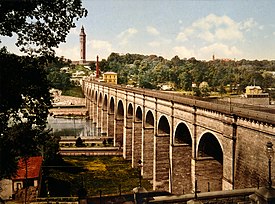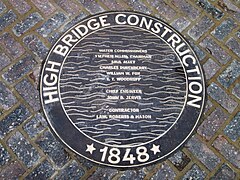High Bridge (New York City)
High Bridge was originally completed in 1848 with 16 individual stone arches. In 1928, the five that spanned the Harlem River were replaced by a single 450-foot (140 m) steel arch. The bridge was closed to all traffic from around 1970 until its restoration, which began in 2009. The bridge was reopened to pedestrians and bicycles on June 9, 2015.
The bridge is operated and maintained by the New York City Department of Parks and Recreation.
History
Background
The High Bridge was part of the first reliable and plentiful water supply system in New York City. As the City was devastated by cholera in 1832 and the Great Fire in 1835, the inadequacy of the water system of wells-and-cisterns became apparent. Numerous corrective measures were examined. In the final analysis, only the Croton River in northern Westchester County was found to carry water sufficient in quantity and quality to serve the City. The delivery system was begun in 1837, and was completed in 1848.
The Old Croton Aqueduct was the first of its kind ever constructed in the United States. The innovative system used a classic gravity feed, dropping 13 inches (330 mm) per mile, or about 1/4" per 100' (~0.02%) and running 41 miles (66 km) into New York City through an enclosed masonry structure crossing ridges, valleys, and rivers. University Avenue was later built over the southernmost mainland portion of the aqueduct, leading to the bridge. Though the carrying capacity was enlarged in 1861–1862 with a larger tube, the bridge became obsolete in 1910 with the opening of the New Croton Aqueduct. In the 1920s, the bridge's masonry arches were declared a hazard to ship navigation by the United States Army Corps of Engineers, and the City considered demolishing the entire structure. Local organizations called to preserve the historic bridge, and, in 1927, five of the original arches across the river were replaced by a single steel span, while the remaining arches were retained.
Construction
Originally designed as a stone arch bridge, the High Bridge had the appearance of a Roman aqueduct. Construction on the bridge was started in 1837, and was completed in 1848 as part of the Croton Aqueduct, which carried water from the Croton River to supply the then burgeoning city of New York some 10 miles (16 km) to the south. The bridge has a height of 140 ft (43 m) above the 620-foot-wide (190 m) Harlem River, with a total length of 1,450 ft (440 m). The design of the bridge was originally awarded to Major David Bates Douglass, who was fired from the project. The design then fell to the aqueduct's engineering team, led by John B. Jervis. James Renwick Jr., who later went on to design the landmark Saint Patrick's Cathedral on Fifth Avenue in Midtown Manhattan, participated in the design.










